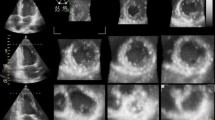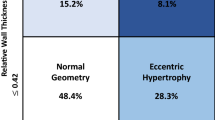Abstract
Intense exercise has been shown to have negative effects on systolic and diastolic ventricular function in adults. Very little is known about the normal reaction of the growing heart to endurance stress. For this study, 26 healthy children (18 males) with a mean age of 12.61 years (range, 7.92–16.42 years) took part in an age-adapted triathlon circuit. The athletes were investigated by two-dimensional (2D) echocardiographic/speckle tracking, M-mode, pulse-wave Doppler, color Doppler, and color-coded tissue Doppler at 2–4 weeks before and immediately after the race. After the competition, cardiac output increased, mediated by an increase in heart rate and not by an elevated preload, according the Frank–Starling mechanism. Two-dimensional speckle tracking showed a reduced longitudinal strain in the right and left ventricles and additionally reduced circumferential strain in the left ventricle. The late diastolic inflow velocities were increased in both ventricles, indicating reduced diastolic function due to an impairment of myocardial relaxation. Immediately after endurance exercise, systolic and diastolic functions were attenuated in children and adolescents. In contrast to adult studies, this study could show a heart rate-mediated increase in cardiac output. The sequelae of these alterations are unclear, and the growing heart especially may be more susceptible to myocardial damage caused by intense endurance stress.

Similar content being viewed by others
References
Abali G, Tokgozoglu L, Ozcebe OI, Aytemir K, Nazli N (2005) Which Doppler parameters are load independent? A study in normal volunteers after blood donation. J Am Soc Echocardiogr 12:1260–1265
Avabakan C, Akalin F, Mengütav S, Cotuk B, Odabas I, Ozüak A (2006) Athletes heart in prebubertal male swimmers. Cardiol Young 16:61–66
Bellinger AM, Mongillo M, Marks AR (2008) Stressed out: the skeletal muscle ryanodine receptor as a target of stress. J Clin Invest 118:445–453
Burns AT, Connelly KA, La Gerche A, Mooney DJ, Chan J, MacIsaac AI, Prior DL (2007) Effect of heart rate on tissue Doppler measures of diastolic function. Echocardiography 24:697–701
Cain B, Meldrum D, Joo K (1998) Human SERCA2a levels correlate inversely with age in senescent human myocardium. J Am Coll Cardiol 32:458–467
Ebashi S (1991) Excitation-contraction coupling and the mechanism of muscle contraction. Annu Rev Physiol 53:1–16
Greenberg N (2002) Doppler-derived myocardial systolic strain rate is a strong index of left ventricular contractility. Circulation 105:99
Grossman W (1986) Evaluation of systolic and diastolic function of the myocardium. In: Grossman W (ed) Cardiac catheterization and angiography, 3rd edn. Lea & Febiger, Philadelphia, pp 301–319
Hart E, Dawson E, Rasmussen P, George K, Secher NH, Whyte G, Shave R (2006) Beta-adrenergic receptor desensitization in man: insight into post-exercise attenuation of cardiac function. J Physiol 577:717–725
Hasenfuss G (1998) Calcium pump overexpression and myocardial function: implications for gene therapy and myocardial failure. Circ Res 83:966–968
Hatle L (2007) How to diagnose diastolic heart failure: a consensus statement. Eur Heart J 28:2421–2423
Hopkins SR, Gavin TP, Siafakas NM, Haseler LJ, Olfert IM, Wagner H, Wagner PD (1998) Effect of prolonged, heavy exercise on pulmonary gas exchange in athletes. J Appl Physiol 85:1523–1532
Joulin O, Marechaux S, Hassoun S, Montaigne D, Lanel D, Neviere R (2009) Cardiac force-frequency relationship and frequency-dependant acceleration of relaxation are impaired in LPS-treated rats. Crit Care 13:R14
Klabunde RE (2005) Cardiovascular physiology concepts 2005. Betty Sun (ed). Lippincott Williams & Wilkins, Baltimore
Korinek J, Wang J, Sengupta PP, Miyazaki, Kjaergaard J, McMahon E, Abraham TP, Belohlavek M (2005) Two-dimensional strain: a Doppler-independent ultrasound method for quantification of regional deformation: validation in vivo and in vitro. J Am Soc Echocardiogr 18:1247–1253
Koskenvuo JW, Mirsky R, Zhang Y, Angeli FS, Jahn S, Alastalo TP, Schiller N, Boyle AJ, De Marco T, Yeghiazarians Y (2010) A comparison of echocardiography to invasive measurement in the evaluation of pulmonary arterial hypertension in a rat model. Int J Cardiovasc Imaging 26:509–518
La Gerche A, Conelly KA, Mooney DJ, Mac Isaac AJ, Prior DL (2008) Biochemical and functional abnormalities of left and right ventricular function after ultra-endurance exercise. Heart 94:860–866
Lai WW, Geva T, Shirali GS, Frommelt PC, Humes RA, Brook MM, Pignatelli RH, Rychik, Task Force of the Pediatric Council of the American Society of Echocardiography, Pediatric Council of the American Society of Echocardiography (2006) Guidelines and standards for performance of a pediatric echocardiogram: a report from the Task Force of the Pediatric Council of the American Soitey of Echocardiography. J Am Soc Echocardiogr 19:1413–1430
Neilan TG, Januzzi JL, Lee-Lewandrowski E, Ton-Nu TT, Yoerger DM, Jassal DS, Lewandrowski KB, Siegel AJ, Marshall JE, Douglas PS, Lawlor PS, Picard MH, Wood MJ (2006) Myocardial injury and ventricular dysfunction related to training levels among nonelite participants in the Boston marathon. Circulation 114:2325–2333
Neilan TG, Yoerger DM, Douglas PS, Marshall JE, Halpern EF, Lawlor D (2006) Persistent and reversible cardiac dysfunction among amateur marathon runners. Eur Heart J 27(9):1079–1084
Nottin S, Doucende G, Schuster-Beck I, Tanguy S, Dauzat M, Obert P (2009) Alteration in left ventricular strains and torsional mechanics after ultra-long-duration exercise in athletes. Circ Cardiovasc Imaging 2:323–330
Obert P, Stecken F, Courteix D, Lecoq AM, Guenon P (1998) Effect of long-term intensive endurance training on left ventricular structure and diastolic function in prepubertal children. Int J Sports Med 19:149–154
Oxborough D, Shave R, Warburton D, Williams K, Oxborough A, Charlesworth S, Foulds H, Hoffmann MD, Birch K, George K (2011) Dilatation and dysfunction of the right ventricle immediately after ultra-endurance exercise: exploratory insights from conventional two-dimensional and speckle tracking echocardiography. Circ Cardiovasc Imaging 4:253–263
Pfaffenberg RS Jr, Hyde RT, Wing AL, Lee IM, Jung DL, Kampert JB (1993) The association of changes in physical activity level and other lifestyle characteristics with mortality among men. N Engl J Med 328:538–545
Roche SL, Vogel M, Pitkänen O, Grant B, Slorach C, Fackoury C, Stephens D, Smallhorn J, Benson LN, Kantor PF, Redington AN (2011) Isovolumic acceleration at rest and during exercise in children: normal values for the left ventricle and first noninvasive demonstration of exercise-induced force-frequency relationships. J Am Coll Cardiol 57:1100–1107
Sutherland G (2004) Strain and strain rate imaging: a new clinical approach to quantifying regional myocardial function. J Am Soc Echocardiogr 17:788
Teske AJ, Prakken NH, De Boeck BE, Velthuis BK, Mertens EP, Doevendans PA, Cramer M (2009) Echocardiographic tissue deformation imaging of right ventricular systolic function in endurance athletes. Eur Heart J 30:969–977
Author information
Authors and Affiliations
Corresponding author
Rights and permissions
About this article
Cite this article
Hauser, M., Petzuch, K., Kühn, A. et al. The Munich Triathlon Heart Study: Ventricular Function, Myocardial Velocities, and Two-Dimensional Strain in Healthy Children Before and After Endurance Stress. Pediatr Cardiol 34, 576–582 (2013). https://doi.org/10.1007/s00246-012-0500-8
Received:
Accepted:
Published:
Issue Date:
DOI: https://doi.org/10.1007/s00246-012-0500-8




